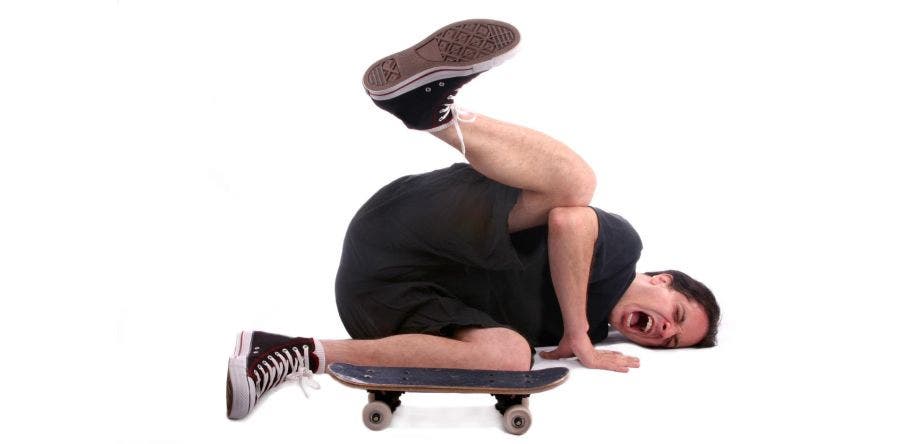Injuries to Know About When Skateboarding
Skateboarding has always been a popular sport among children and teenagers, but with its recent appearance in the latest Summer Olympics it has gained a lot of attention. With spin-offs of skateboarding like off-roading and downhill it has only increased in popularity amongst a wide variety of ages.
While it is an excellent cardio exercise providing fun and excitement, skateboarding also has some of the highest injuries numbers. It is estimated that over 70,000 injuries a year happen due to skateboarding that require a trip to the emergency room. Luckily, many injuries can be prevented with the right training, locations, and protective gear.
Most Common Skateboarding Injuries
The majority of skateboarders are between the ages of 10-20 years old, meaning a lot of them still have developing bones. Almost half of all skateboarding injuries are in the 15 and under age group, mainly boys.
Injuries can happen for a variety of different reasons, losing balance, falling off the skateboard, or improper fall technique. Common areas for injury are the wrist, ankle, and face.
● Wrist fractures top the list of skateboarding injuries. Wearing wrist guards is an excellent preventative measure that has been effective to reduce the amount and severity of wrist injury.
● Broken noses and jawbones are also common and can be better prevented by learning proper technique and not performing tricks above your skill level.
● Common, less impactful injuries reported are cuts, bruises, sprained ankles, and strained muscles.
● Concussions and other head injuries have been known to happen and wearing a helmet can greatly reduce this statistic.
Children are at a higher risk of experiencing injuries. If your child is between the ages of 6-10 they should be closely supervised by an adult when riding, and children under 5 should not ride skateboards according to the American Academy of Pediatrics.
Younger children are at higher risk for several reasons. These include:
● Less developed balance and center of gravity making them more prone to falling and head injury
● Reaction times are slower and coordination is not as strong as adults. This means that falling can happen quicker and oftentimes harder.
● Overestimating or lack of fear when trying new skills can lead to poor judgment of speed, traffic, and obstacles.
Wear Proper Protective Gear
Having proper protective gear is essential to preventing injuries when skateboarding. Purchasing wrist guards and knee and elbow pads help reduce the severity of falls and limit injuries. Closed toe shoes with slip resistant soles and even goggles or glasses to keep debris out of eyes is recommended.
Helmets above all are extremely important to protect your head from injury. This is true no matter your experience or age level when skateboarding. A bike or sport helmet that meets the U.S Consumer Product Safety Commission (CPSC) and fits securely is recommended. You will know your helmet fits properly when it is:
● Sits flat on the head and low on your forehead with bottom edge parallel to ground
● Side straps should form a “V” shape around the ears
● Buckle is tightly fastened (no more than two fingers between skin and strap)
● Does not move around when head is shaking
Ensure Appropriate Equipment
Skateboards come in a variety of shapes and sizes. You will want to visit your local skate shop or research online to make sure you choose the appropriate board for the style of skateboarding you are doing and also note that some are rated for the user's weight.
Applying a quality skateboard griptape is also instrumental in preventing injuries. The griptape can feel like sandpaper and provides skaters the traction required to keep their feet better stuck to the board. Griptape should be replaced occasionally- depending on how often you skateboard and if your board gets wet that could be monthly or twice a year.
If you are performing tricks or taking your board on rough terrain you’ll likely experience some cracks or breaks. This could be loose parts, sharp edges on the board, or wheels with nicks and cracks. Make sure to repair serious defects immediately and don’t skateboard until everything is in good working order.
Practice Your Technique
Like any sport, you will want to practice and master the basic skills before trying more challenging maneuvers and tricks. The first lesson in safe skateboarding it learning how to stop, slow, turn, and fall.
Falling will be part of skateboarding for any skateboarder- it just happens. However, knowing how to properly fall can prevent serious injuries, especially wrist fractures. Crouch down on the skateboard if you are losing balance so you don't have to fall as far and also practice rolling out of falls to protect your wrists.
Stay Safe Skateboarding
Skateboarding is a fun and challenging sport. It is a great personal sport and fun to do with friends. Practicing in a controlled environment like a skate park with a chaperone and with appropriate safety gear is a great start to preventing injuries.
Jessup Manufacturing has long been a leader in skateboard griptape. Our silicon carbide formula ensures your shoes stay intact while your feet stay on the skateboard. To shop our entire line of various designs and sizes of skateboard grip tape visit our website jessupmfg.com.


















